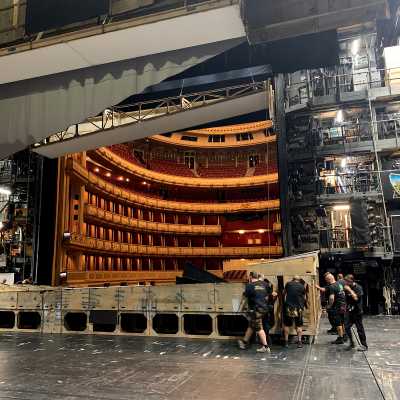Stage Environment Unit
Stage Environment Unit Description
The stage environment unit encompasses the competences needed to handle and maintain scenic elements.
The personnel who install, handle, and move scenic elements are commonly referred to as stage technicians. Many different forms of scenery used can be found in many event and live-performance settings, including the theatre, corporate events, concerts, trade shows, broadcast television and other types of live events.
The unit does NOT refer to mechanical equipment used to move scenery (Mechanical Equipment Unit).
The competences listed in TeBeVAT are common for stage technicians in all areas in the sector.
Photo: © Randell Greenlee
Scope note
ESCO: essential skills/competences of
Theatre Technician
Stage Technician
Competences
The Work Organisation Unit competences are a prerequisite as a basis for all units.
Planning (10)
03 00 10 04 10 - Draw stage layouts (Sketch or manually draw stage layouts, which depicts the arrangement of various elements on stage.)
03 10 10 04 30 - Provide documentation (Prepare and distribute documentation to ensure all people involved in the production receive relevant and up‐to‐date information.)
70 20 10 04 30 - Plan teamwork (Organise the working schedule of a group of people in order to meet all time and quality requirements.)
70 30 10 05 10 - Develop project schedule (Define the project completion stages and create a timeline. Synchronise necessary activities, taking into account the convergence of production elements. Establish a schedule.)
70 56 10 05 30 - Budget set costs (Prepare set production budgets.)
Preparing (20)
03 00 20 04 10 - Set up technical stage equipment (Install mechanical and technical stage equipment. Test the installation to make sure everything is in working order.)
03 00 20 03 20 - Assemble scenic elements on stage (Fix scenic elements, dance and stage floors and stage cloths, based on written documents.)
03 00 20 03 21 - Assemble the rehearsal set (Put together all prepared scenic elements to prepare the rehearsal set.)
03 00 20 04 30 - Prevent technical problems with scenic elements (Anticipate possible technical problems with scenic elements.)
03 00 20 04 31 - Prevent technical problems with stage equipment (Anticipate possible problems with mechanical and electromechanical stage equipment.)
03 10 20 04 31 - Mark the information from the ground plans on the stage area (Interpret the designs and other scenic drawings to clearly mark the information from the ground plans to the stage area.)
04 00 20 03 10 - Assemble performance equipment (Set up sound, light and video equipment on stage before performance event according to specifications.)
04 50 20 03 50 - Install temporary audience accommodation (Place audience accommodation, fixing it into place with a scaffolding system if required.)
70 58 20 04 20 - Ensure visual quality of the set (Inspect and amend the scenery and set‐dressing to make sure the visual quality is optimal within constraints of time, budget and manpower.)
Rehearsing (30)
03 00 30 03 40 - Handle scenic elements during rehearsal (Operate and assemble equipment and scenery material during rehearsal or onstage.)
12 00 30 03 20 - Dismantle the rehearsal set (Take apart all prepared scenic elements after the rehearsal.)
Running the Show (40)
00 00 40 03 10 - Communicate during show (Interact efficiently during a live performance, in order to anticipate any possible malfunctionings.)
03 10 40 04 22 - Interact with actions on the stage (Take cues from actions on the stage and interact with them. Take decisions on the exact timing and procedures in a live environment in order to produce a fluid and consistent performance.)
03 10 40 03 22 - Follow time cues (Observe the conductor, orchestra or director and follow text and vocal scores to time cues accurately.)
12 00 40 03 10 - Change scenic elements during performance - (Adjust scenic elements during a performance and follow the relevant documentation.)
After the Show (50)
00 00 50 03 10 - De‐rig electronic equipment (Remove and store various types of electronic equipment safely after use.)
00 00 50 03 20 - Store performance equipment (Dismantle sound, light and video equipment in a safely manner after a performance event. Make sure the equipment is correctly stored away.)
Maintenance (60)
12 20 60 04 10 - Maintain theatre sets - (Install, check, maintain and repair stages and sets.)